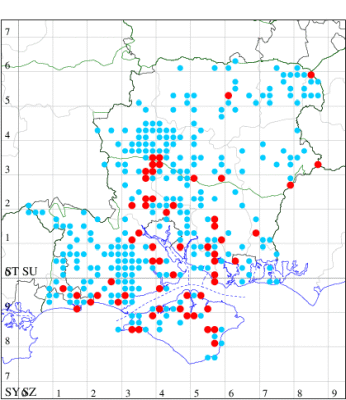2022 Annual Report for: Limacodidae / Limacodinae
For species seen in 2022 that had less than or equal to 100 records, full details are included; for more common species, the earliest, latest and highest count by vice-county are shown. The narrative for each species is taken from the main Hantsmoths website, and it is possible that some information on abundance and occurrence can get out of date, as it is impossible to keep up with all changes; however it should give a good introduction to each species. The tables in each species account summarise the previous status, and that for the current year.
For the maps, all records prior to 2022 are shown by a blue dot (the larger the dot, the more recent), with the current year's records shown in red. As previous records are superimposed on any report for 2022, new sites have greater emphasis (i.e. will show as 'more red').
In the species accounts, an asterisk next to a location indicates a new 10km square record; earliest ever dates are highlighted in orange, and latest ever in red. Initials in the species accounts refer to the recorders listed here. Please get in touch if you identify any omissions or errors, in particular if you have records that have yet to be submitted. Details of how to submit records can be found here.
53.001 [B&F: 0173] Festoon Apoda limacodes (Hufnagel, 1766) - Nb
Nationally scarce (Nb) in broad-leaved woodland and hedgerows throughout much of south-eastern England. In Hampshire and on the Isle of Wight appears to be one of the species which is benefiting from the increase in average summer temperatures in recent years, with a marked increase apparent in the last ten years, and more than 120 records received in 2006. Wingspan male 24-28 mm, female 27-32 mm. Unmistakable. Larva feeds on Oak and Beech, over-wintering in a cocoon.
Records prior to 2022
| Vice County | #Records | #Individuals | First Record | Last Record |
|---|---|---|---|---|
| 10 | 216 | 455 | 1800 | 2021 |
| 11 | 1349 | 2184 | 1800 | 2021 |
| 12 | 451 | 665 | 1900 | 2021 |
2022 records
| Vice County | #Records | #Individuals | Max Quantity |
|---|---|---|---|
| 10 | 33 | 91 | 15 |
| 11 | 107 | 144 | 6 |
| 12 | 13 | 13 | 2 |

Records by year
Records by week (adult)
Records by week (larval)
Record Summary
VC10: Earliest: Freshwater Bay, 10 Jun, 1 (SDav) Latest: Shanklin, 31 Jul, 1 (IOu) Max count: Shanklin, 12 Jul, 15 (IOu)
VC11: Earliest: Chandlers Ford, 12 Jun, 1 (AMur) Latest: Allbrook, 21 Jul, 1 (SIng) Max count: Needs Ore NNR, 09 Jul, 25 (CNB)
VC12: Earliest: Hammer Vale, Woolmer, 10 Jun, 1 (ASwa) Latest: Hammer Vale, Woolmer, 19 Jul, 1 (ASwa) Max count: Basingstoke, 19 Jul, 2 (MJW)
53.002 [B&F: 0174] Triangle Heterogenea asella ([Denis & Schiffermüller], 1775) - Nationally Scarce
A rare Red Data Book species in oak and beech woodland. There are post-1980 records from Essex, Kent, East Sussex, Hampshire, south Wiltshire, Devon and Cornwall, but the species is very local and scarce throughout its range. In Hampshire most records come from the New Forest where it is now scarce, although annual on Wickham Common: some signs that there has been a recent upturn in sightings in recent years, and it was recorded from the Isle of Wight for the first time in 2015. Wingspan male 14-19 mm, female 16-22 mm. Larva feeds on Oak and Beech, over-wintering in a cocoon.
Records prior to 2022
| Vice County | #Records | #Individuals | First Record | Last Record |
|---|---|---|---|---|
| 10 | 7 | 29 | 2015 | 2017 |
| 11 | 83 | 76 | 1940 | 2018 |
| 12 | 4 | 3 | 1981 | 2003 |
2022 records
| Vice County | #Records | #Individuals | Max Quantity |
|---|---|---|---|
| 10 | 2 | 2 | 1 |
| 11 | 3 | 3 | 1 |

Records by year
Records by week (adult)
Records by week (larval)
Record Details
VC10: Shide, Newport*, one, moth Trap (20W Skinner). ID confirmed by Iain Outlaw who has seen this species before, and Jim Baldwin, 19 Jul; one, 18 Jul (CViny);
VC11: Wickham, one, 22 Jun (JRDS); Upham*, one, female. (3 lamps), 01 Jul (PAB, KCok & RJD); Lymington, one, 15 Jul (PRD)